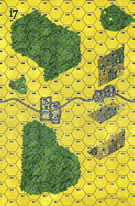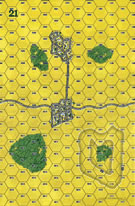|
Dutch Treat Road to Berlin #69 |
||
|---|---|---|
| (Attacker) Germany | vs | Soviet Union (Defender) |
| Formations Involved | ||
|---|---|---|
| Germany |  |
23rd SS "Nederland" Panzergrenadier Division |
| Soviet Union |  |
88th Guards Rifle Division |

|
| Overall Rating, 3 votes |
|---|
|
2.67
|
| Scenario Rank: --- of 940 |
| Parent Game | Road to Berlin |
|---|---|
| Historicity | Historical |
| Date | 1945-04-19 |
| Start Time | 08:00 |
| Turn Count | 24 |
| Visibility | Day |
| Counters | 69 |
| Net Morale | 1 |
| Net Initiative | 2 |
| Maps | 3: 15, 17, 21 |
| Layout Dimensions | 84 x 43 cm 33 x 17 in |
| Play Bounty | 105 |
| AAR Bounty | 171 |
| Total Plays | 3 |
| Total AARs | 1 |
| Battle Types |
|---|
| Rural Assault |
| Urban Assault |
| Conditions |
|---|
| Off-board Artillery |
| Randomly-drawn Aircraft |
| Scenario Requirements & Playability | |
|---|---|
| Road to Berlin | Base Game |
| Introduction |
|---|
|
Far too little and far too late, the German high command had called in reinforcements to stem the Soviet march to Berlin. Among these was a "division" of Dutch volunteers, actually little more than a reinforced regiment. Having backed the losing side, the Dutchmen had even less hope of mercy from the Soviets than did German SS men, and when ordered to counter-attack the Soviet advance they fought with all the courage of cornered rats. |
| Conclusion |
|---|
|
The Dutch Nazis caught the Soviets by surprise, and drove them out of Marxdorf. After their initial success, an attempt to expand their perimeter by seizing ground northeast of the town met heavy Soviet fire and the SS fell back with heavy losses. Unable to regain their momentum, the Dutch traitors would have to watch the Soviet advance grind forward again. |
| AFV Rules Pertaining to this Scenario's Order of Battle |
|---|
|
| 3 Errata Items | |
|---|---|

|
All SS 75mm IG guns are direct fire weapons (black), not indirect (white). (Shad
on 2010 Dec 15)
|

|
The reduced direct fire value of the SS HMG is 5-5 in Beyond Normandy and Road to Berlin. (plloyd1010
on 2015 Jul 31)
|

|
These units should have a Direct Fire rating of 2-3, just like the RKKA and NKVD counterparts. (danradz
on 2011 May 04)
|
| Operation Toehold | ||||||||||||
|---|---|---|---|---|---|---|---|---|---|---|---|---|
The Dutch used a two thrust attack. In the center, coming down the road, came the armor with supporting GRENS. To the south came the GRENS, supported with mortars and a 75IG. Loaded HT's were sent from the north edge to keep Soviet INF that could otherwise be used as reinforcements. The Soviets had set up AT guns in the small center wood and southern woods on Map 17. The westernmost town on Map 17 was defended with INF and HMG. Their 76.2's were set in the easternmost town, ready to serve double duty with HE and AT rounds. The Dutch forces moved in and soon occupied the towns on Map 21. The center forces were to eliminate the small woods of enemy units and hit the westernmost town on Map 17 from the northwest. The southern forces were to punch make their way through the woods and hit the towm from the south. Once in position, their forces moved forward. Almost immediately, a recurring theme throughout the action introduced itself. The Dutch Nazis' lower morale became painfully apparent. They broke fast and rallied slowly, if at all. To their shame, there were some units that spent more time cowering in wooded cover than engaging the enemy. However, those units that pressed on managed to damage the Soviets, including Dutch armor hunting down and eliminating the Soviet SP guns. Their shining moment, however, came on an attack on the town. DF from their panzers managed to demoralize both HMG units defending the town as well as their leader. The demoralized Soviet units, reduced from failing further morale checks from additional fire, abandoned their position, with the Dutch soon moving in. What good-order units the Dutch had, intrepidly assaulted two more hexes in the town. Both sides used the same strategy: isolate the units inside the town from reinforcements. The Dutch had panzers and HT's in the town. The Soviets had INF and superior morale. The Soviets also had superior artillery. Any rallying Dutch had more OBA raining down on them, setting back their recovery. The Soviets also had AT-capable air support that wound up devastating the Dutch. The Soviet superiority in support and morale began to show. Their forces in the assault hexes began to rally and counterattack. They took back most of the town. But as 1400 rolled around, the Dutch managed to keep just enough of it with rapidly dwindling forces to claim a victory. It was victory of the barest kind. It left both sides wondering what would have happened if the battle had raged on another fifteen minutes. A special commendation goes to the Dutch mortar units. Their ceaseless fire managed to disrupt and demoralize many a Soviet unit that was meant to reinforce the town. If you're looking for an action with lots of carnage and where a few rolls of the dice can make a big difference, this might be one for you. |
||||||||||||
| 0 Comments |

 RtBr068
RtBr068 

























